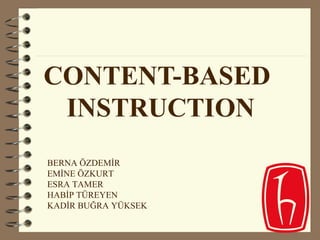
Content-Based Instruction Guide
- 1. BERNA ÖZDEMİR EMİNE ÖZKURT ESRA TAMER HABİP TÜREYEN KADİR BUĞRA YÜKSEK
- 2. CONTENT I. Content- based Instruction A.Introduction a. What is CBI? b. Types of CBI B.Rationale for Content-based Instruction C.Experience D. Thinking about the Experience E.Reviewing the Principles F.Reviewing the Techniques Conclusion
- 4. Content–based Instruction refers to an approach to second language teaching in which is organized around the context or information that students will acquire, rather than around a linguistic or other type of syllabus. Content–based Instruction refers to an approach to second language teaching in which is organized around the context or information that students will acquire, rather than around a linguistic or other type of syllabus.
- 5. «Language as a vehicle for learning content.»«Language as a vehicle for learning content.»
- 6. Howatt(1984): there are two versions of communicative approach : strong form weak form
- 7. a strong version a weak version give students opportunities to practice communication to practice English for communicative purposes entails ‘using English to learn it’ could be described as ‘ learning to use’ English
- 9. CBI as a method with many faces… Task is often used with reference to both content and methodology.. Syllabus design and methodology blurred
- 10. CBI as particular examples of a task-based approach. Task-based participatory Content-based
- 11. Students would learn the language as a by-product of learning. Classroom should focus on communication.
- 12. The Central Principles 1.People learn L2 more succesfully when using language as a means of acquiring information. 2. CBI reflects learners’ needs for learning a second language.
- 13. TYPES OF CBI 1. Theme-based language instruction 2. Sheltered content instruction 3. Adjunt language instruction 4. Team-teach approach 5. Skill-based approach
- 14. Rationale for Content- based Instruction • Thought of as teaching a ‘language for specific purposes’ (LSP) • In academic settings, language for academic purposes • Competency-based instruction is by studying vital ‘life-coping’ or ‘survival skills’
- 15. • not exclusively a language program, but instead it integrates the learning of language • ‘language across the curriculum’ • teaching academic subjects, such as history or science • content and language integrated learning (CLIL) • amalgam of language learning and subject learning
- 16. • first to establish literacy in their native language • second to draw on what is known about how children learn
- 19. Observations Principles 1. Studying geography through the target language Content and language are targets for learning. 2. Asking to students about a globe Previous experience 3. Supplying the missing language in any trouble Scaffolding the linguistic content 4. Calling out the answers, writing them on the blackboard Perceiving the relevance of language use
- 20. Observations Principles 6. Fill-in the blanks exercises Vocabulary is easier to acquire when there are contextual clues. 7. Providing examples using present passive with lattitude and longtitude coordinates When working authentic subject, students need language support. 8Finding cities on the globe Working with meaningful, cognitively demanding language 9. Using a dictogloss, discussing its organization Learning discourse organization of academic texts
- 22. The goals of teachers Master language and content Encourage the development
- 23. The role of teacher and students . A good language teacher .Knowledgeable in the subject matter .Be able to draw out that knowledge from students . Students’ role is to engage content and language.
- 24. The characteristics of the teaching/learning process Understanding authentic texts Making meaning clear Designing activities Highlighting how language is used
- 25. The nature of student- teacher and student- student interaction Teacher guides student learning Supporting them Students often work collaboratively
- 27. The view of language and cultureLanguage is meaningful Culture is addressed in teaching.
- 28. Emphasized areas and skills of language The role of the students’ native language
- 30. Teacher Preparation Having content and language knowledge Helping teachers to understand the rationale Giving teachers practice designing Sheltered Instruction Observation Protocol (SIOP) Adjunct Model Focusing on helping the students ; such as, -Comleting academic tasks -Improving note-taking activities -Reading academic textbooks
- 31. Whole Language used with second language learners language to be regarded holistically rather than pieces working from top-down not the bottom-up providing content- rich curriculum errors as part of learning colloboration between teacher and students zone of proximal development
- 33. Dictogloss first listening is for the main idea the second is for details working with a partner or in a small group
- 34. Graphic Organizer visual displays including diagrams, tables, columns and webs facilitating recall of cognitively demanding content
- 35. Language Experience Approach writing story about their life experiences practicing reading with the assistance of teacher
- 36. Process writing brainstorming about the topic product-oriented’ collect and evaluate what students have written shifting the emphasis in teaching writing
- 37. Dialogue Journals keeping dialogue in journals Using journals in class or for homework writing a response but not correcting form
- 38. CONCLUSION
